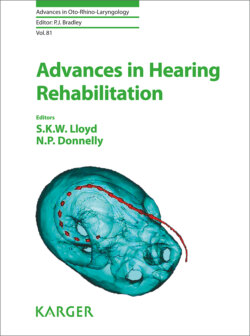Читать книгу Advances in Hearing Rehabilitation - Группа авторов - Страница 55
На сайте Литреса книга снята с продажи.
Bone Conduction Devices in SSD
ОглавлениеThere are thought to be approximately 9,000 new diagnoses of SSD in the UK each year, with 24% of sufferers having to give up work as a result [32]. Commonly reported issues from SSD patients include social exclusion associated with difficulties keeping up with group conversations, dangers as a pedestrian as well as increased problems with communication in the workplace [32]. Since sufferers have only one working cochlea, they cannot process any interaural cues and so lack the ability to derive any of the normal benefits of binaural processing, such as improved sound localization and understanding of speech in background noise [33]. Treatment options of SSD include education related to the best sitting positions in noisy environments to make the most use of monaural clues. Hearing devices are also available in the form of a Contralateral Routing of Signal (CROS) hearing aid and a BCHI. Several countries have also approved cochlear implantation as a treatment option [34].
In 2002, the FDA approved the use of BCHI for SSD. Since then, there has been an increasing number of patients being treated with this method [37]. Although binaural hearing cannot be restored, the BCHI makes use of the relatively limited transcranial attenuation to allow sound from the deaf side to be transferred to the contralateral side. This aims to improve the detection of sound when the sound is laterally projected to the deaf side [38].
Patients with congenital SSD are an important subgroup who are at a greater risk of learning problems at school when compared to those with normal hearing [35]. Prevalence rates of congenital SSD are estimated to be in the region of 0.1% [36]. It has been theorized that these patients may not benefit as much from treatment with either BCHI or CROS, because such patients have always relied on a monaural strategy of processing pinna-induced spectral-shape cues. However, research has failed to find significant evidence for this hypothesis, instead discovering that localization ability in patients with SSD is dependent on high-frequency cues [34].
Despite much published literature, evidence for the benefit of BCHI in SSD is inconsistent with most subjective studies showing benefit, while most objective studies do not. A recent review concluded that there was a lack of high level evidence for both BCHI and CROS in SSD [39]. A summary of both subjective and objective results is presented in Table 1.
In the subjective studies, measures such as the abbreviated profile of hearing aid benefit have been widely used. This comprises assessment in a number of domains including: ease of communication, background noise, reverberation, aversion to loud noise, as well as a global score. Studies consistently found significant improvements in ease of communication and in the background noise domains. In contrast, scores tended to be poorer in the assessment of aversion to loud noise [40–45]. The single-sided deafness questionnaire is a further commonly used assessment tool which found that the majority of patients use their devices between 4 and 7 h a day and that there was a perceived benefit in QOL and in hearing (particularly, in quiet) [40, 43, 44].
Several objective studies have investigated BCHI via the use of hearing in noise testing, the majority of which have found benefits only when speech is directed to the deaf ear. In this experimental configuration, there is an improvement in thresholds due to compensation of the head shadow effect by BCHI. In the converse condition, however, where speech is directed to the hearing ear and noise to the deaf ear, the hearing threshold worsens due to head shadow being compensated for [40–42, 45, 46]. Thus, overall there is no benefit. Lin et al. [45] reported that the increases in the beneficial condition were greater than the decreases in the detrimental condition, but these differences were not significant. One study of twenty-one patients with SSD and contralateral hearing loss did find significant improvements in speech recognition in both quiet and noise. Since the benefit in noise occurred regardless of a spatial separation between speech and noise, this benefit must be related to improvement in the stimulus audibility, and so might not be sustained if the stimulus were presented at a higher sound level.
Table 1. Summary of study findings investing the use of BCHI for SSD treatment
Future devices may be able to improve hearing in noise testing in BCHI users via communication with an additional microphone on the normal hearing side. Scene classification technology, currently used to benefit cochlear implant users [47], could then adaptively turn the BCHI on and off depending on how favorable the signal-to-noise ratio is on the deaf side.
